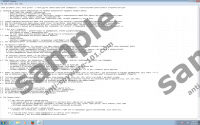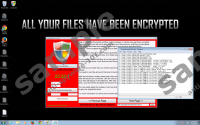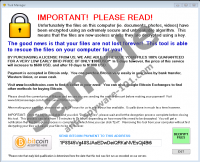Cryptobot Ransomware is a newly crafted ransomware application that will encrypt your files if it enters your operating system. It goes without saying that ransomware infections are among the most dangerous ones since the decryption process of the files is extremely difficult and sometimes even impossible. In order to maintain your system infection-free and keep all your valuable data unharmed, you must delete Cryptobot Ransomware as soon as possible. Your operating system is at constant risk as long as this aggressive malware is present on your PC. Do not hesitate and use the removal guide created by malware experts at Anti-Spyware-101.com to delete Cryptobot Ransomware once and for all. Read more »
Trojans - Page 167 category archyve:
Trojan.LockScreen.EM
Trojan.LockScreen.EM is a serious computer infection that might enter your system without your permission; however, you will definitely notice its presence because you will be presented with notifications (e.g. 3 new backdoors detected or System extremely vulnerable) that will try to convince you that your system is infected with malicious software. You should not trust any word placed on these screen-locking messages because this infection just seeks to scare you even though its main goal is still unknown. Unfortunately, the presence of this threat means that you will not be able to use your computer freely; thus, it is advisable to delete Trojan.LockScreen.EM as soon as possible. The removal process is rather challenging because this computer infection cannot be eliminated via Control Panel, which is why you should read throughout this article in order to get more information about its removal. Read more »
Vanilla virus
Vanilla virus is a term that has been selected to dub one ransomware infection that enters the system surreptitiously and blocks your access to the system. This name is used because the infection displays a ransom warning according to which the victim, i.e. you, has to pay a fine using Vanilla Reload, Moneypak or Reloadit, all of which are money payment systems. The term MoneyPak has already been used to refer to specific ransomware infections, but it does not mean that the payment service is somehow related to the creation of the threat. In the present case, the term Vanilla virus is used because it is a unique example of one more ransomware infection. This threat should be removed from the computer once noticed on the computer, and this recommendation applies to every single malicious program. Read more »
Vanilla Refill virus
The clandestine Vanilla Refill virus is also known as Vanilla Reload Virus, and these names derive from the money transfer system which may be employed by cyber criminals to scam you. Anti-Spyware-101.com researchers warn that there are plenty of devious ransomware Trojans which can introduce you to misleading screen-locking notifications suggesting that you need to pay fines for certain cyber crimes you supposedly have performed. Vanilla Reload, MoneyPak, Ukash, Paysafecard, and other infamous virtual money transfer systems could be employed to collect the so-called fines. In reality, you must remove Vanilla Refill virus without wasting any of your time with the represented demands. Keep in mind that if you postpone the removal, it is possible that your operating system will be infected with more clandestine threats, and your virtual security will become even more vulnerable. Use our guidance within the article to delete the clandestine Vanilla Refill virus right away. Read more »
CTB-Locker
CTB-Locker is one malicious threat you certainly do not want to find running on the operating system. Our researchers analyzing malware in the internal Anti-Spyware-101.com lab have discovered that the threat belongs to the infamous Crypto Ransomware family. CryptoWall, CryptoLocker and Cryptorbit are few other ransomware threats which may attack the operating system. Needless to say, it is a must to delete all of these infections; however, right now we want to focus on CTB-Locker removal. Unfortunately, it is not that easy to delete the threat, primarily because it involves the loss of personal files. If the devious ransomware has already corrupted the operating system, then you must have discovered that many of your document files, photos and videos are now encrypted. So, is there a way to restore the files and delete CTB-Locker? Read the report to find out. Read more »
Asterope Locker
Asterope Locker is a ransomware application that no longer works. This description provides the most general features of Asterope Locker infection, but according to our security researchers; it is virtually impossible to get infected with the application anymore. It might be that the program’s servers could be put back online, but in the meantime it does not seem like it is happening anytime soon. Nevertheless, it is always a good idea to be ready for any malware infection. You may not need to remove Asterope Locker from your PC, but you should always keep a legitimate antimalware application running. Read more »
Your personal files are encrypted
Your personal files are encrypted is the title line of a ransomware warning that is displayed on your screen when the computer is infected with a piece of ransomware called Critroni.A or CTB-Locker_Critoni Ransomware. The Your personal files are encrypted warning is displayed after your files are encrypted, and, in order to regain access to your data, which include a wide range of files, you are supposed to pay 0.5 BTC, which is roughly $240 USD. If you have restarted the computer, and no warning is displayed, it does not mean that you have removed the Your personal files are encrypted infection. Your files are still encrypted, and, if you want to find out what has to be done to regain access to your data, keep reading. Read more »
Cryptographic Locker
Cryptographic Locker is a ransomware application that encrypts almost all of your important files (such as MS Word documents, Adobe reader files, pictures and so on). The program carries out the encryption because it needs leverage when it tries to push innocent users into giving away their money for the supposed decryption code. However, we cannot guarantee that Cryptographic Locker will issue the decryption code even if you pay the money. You have to remove Cryptographic Locker from your computer even if it is not possible to save all the encrypted files. Read more »
Trojan.Ransomcrypt.L
If you cannot access your documents, photos, and other .xls, .pdf, .rar, .mdb, and .zip files, it is very likely that you have encountered a serious infection called Trojan.Ransomcrypt.L. This threat might affect different kinds of systems because it is compatible with all the newer versions of Windows. According to the specialists of anti-spyware-101.com, such an infection might enter the system if you tend to click on advertisements placed on torrent and file sharing websites or just use P2P clients. Actually, it does not matter how it has managed to enter the system because it is still very important to remove Trojan.Ransomcrypt.L. Read more »
ZeroLocker
If you cannot access your files that are placed on the Desktop and notice that the shortcuts in the Taskbar have been corrupted, there is a huge possibility that ZeroLocker, which is a typical ransomware has managed to infiltrate the system. According to the researchers of anti-spyware-101.com, ZeroLocker might be distributed with fake Java installers. You might download them by clicking on ads and fake buttons placed on file sharing and torrent websites. If it happens that you detect WinUpd32.exe file on your system, there are no doubts that ZeroLocker has managed to enter it because this file is known to be associated with this Trojan. Read more »






